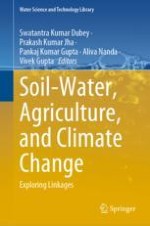This book presents an exploration of linkages among soil-water, agriculture, and climate change with a special focus on thematic areas for assessment, mitigation, and management of natural resources under climate change conditions. This book covers advances in modelling approaches, including machine learning (ML)/ artificial intelligence (AI) applications; GIS and remote sensing; sensors; impacts of climate change on agriculture; subsurface water; contaminants; and socio-economic impacts, which are lacking in a more comprehensive manner in the previous titles. This book encompasses updated information as well as future directions for researchers working in the field of management of natural resources. The goal of this book is to provide scientific evidence to researchers and policymakers and end-to-end value chain practitioners which may help in reducing the overall adverse impacts of climate change on water resources and the related mitigation strategies. This book focuses on the knowledge, modern tools, and techniques, i.e., machine learning, artificial intelligence, etc. for soil-water, agriculture, and climate change. Further, nature-based solutions for management of natural resources with special targets on contaminants, extreme events, disturbances, etc. will be targeted. The book provides readers with the enhanced knowledge for application of engineering principles and economic and regulatory constraints to determine a soil-water, agriculture production action strategy, and select appropriate technologies to implement the strategy for a given data set at a site. It would also cover the application of laboratory, modeling, numerical methods for determination and forecasting of climate change impacts, agriculture production, pollution, soil health, etc. Overall, it provides hydrologists, environmental engineers, administrators, policy makers, consultants, and industrial experts with essential support in effective management of soils health, agricultural productions, and mitigation of extreme climatic events.
